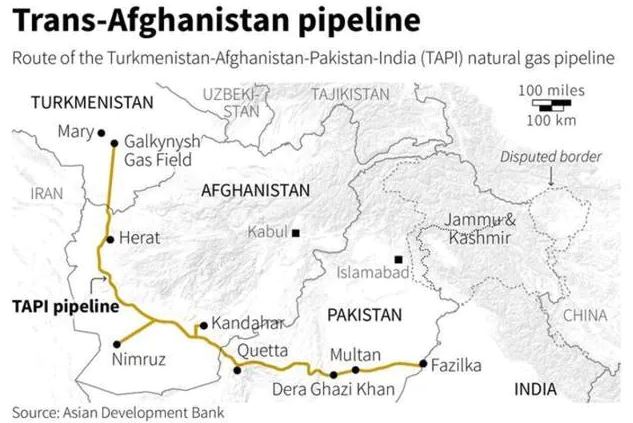Note4Students
From UPSC perspective, the following things are important :
Prelims level: Darvaza Gas Crater, TAPI gas pipeline
Mains level: Not Much

Turkmenistan President has ordered experts to find a way to extinguish a fire in a huge natural gas crater, the Darvaza gas crater also known as the ‘Gateway to Hell’.
Darvaza Gas Crater
- Located in the Karakum desert, 260 kilometres away from Turkmenistan’s capital, Ashgabat, the crater has been burning for the last 50 years.
- The crater is 69 metres wide and 30 metres deep.
- While the details of the origin of the crater are contested but it has been said that the crater was created in 1971 during a Soviet drilling operation.
- In 1971, Soviet geologists were drilling for oil in the Karakum desert when they hit a pocket of natural gas by mistake, which caused the earth to collapse and ended up forming three huge sinkholes.
Why is it flamed?
- This pocket of natural gas contained methane, hence to stop that methane from leaking into the atmosphere, the scientists lit it with fire, assuming the gas present in the pit would burn out within a few weeks.
- The scientists seemed to have misjudged the amount of gas present in the pit, because the crater has been on fire for five decades now.
A popular tourist attraction
- The crater has become a significant tourist attraction in Turkmenistan.
- In 2018, the country’s president officially renamed it as the “Shining of Karakum”.
Why did Turkmenistan order to extinguish it?
- Calling it a human-made crater, it has negative effects on both environment and the health of the people living nearby.
- It also ends up losing valuable natural resources for which could fetch significant profits.
How harmful are methane leaks?
- Methane is the primary contributor to the formation of ground-level ozone, a hazardous air pollutant and greenhouse gas, exposure to which causes 1 million premature deaths every year.
- Methane is also a powerful greenhouse gas. Over a 20-year period, it is 80 times more potent at warming than carbon dioxide.
Back2Basics: TAPI Gas Pipeline

- The Turkmenistan–Afghanistan–Pakistan–India (TAPI) Pipeline is a natural gas pipeline being developed with the participation of the Asian Development Bank.
- It will be a 1,814km trans-country natural gas pipeline running across four countries.
- It will transport natural gas from the Galkynysh Gas Field in Turkmenistan through Afghanistan into Pakistan and then to India.
- The plan for the TAPI project was originally conceived in the 1990s to generate revenue from Turkmenistan’s gas reserves by exporting natural gas via Afghanistan to Pakistan and India.
- Construction on the project started in Turkmenistan on 13 December 2015, work on the Afghan section began in February 2018, and work on the Pakistani section was planned to commence in December 2018.
- Presently, the construction work has been stalled due to terror activities of Taliban in Afghanistan since few years.
UPSC 2022 countdown has begun! Get your personal guidance plan now! (Click here)
Get an IAS/IPS ranker as your 1: 1 personal mentor for UPSC 2024
